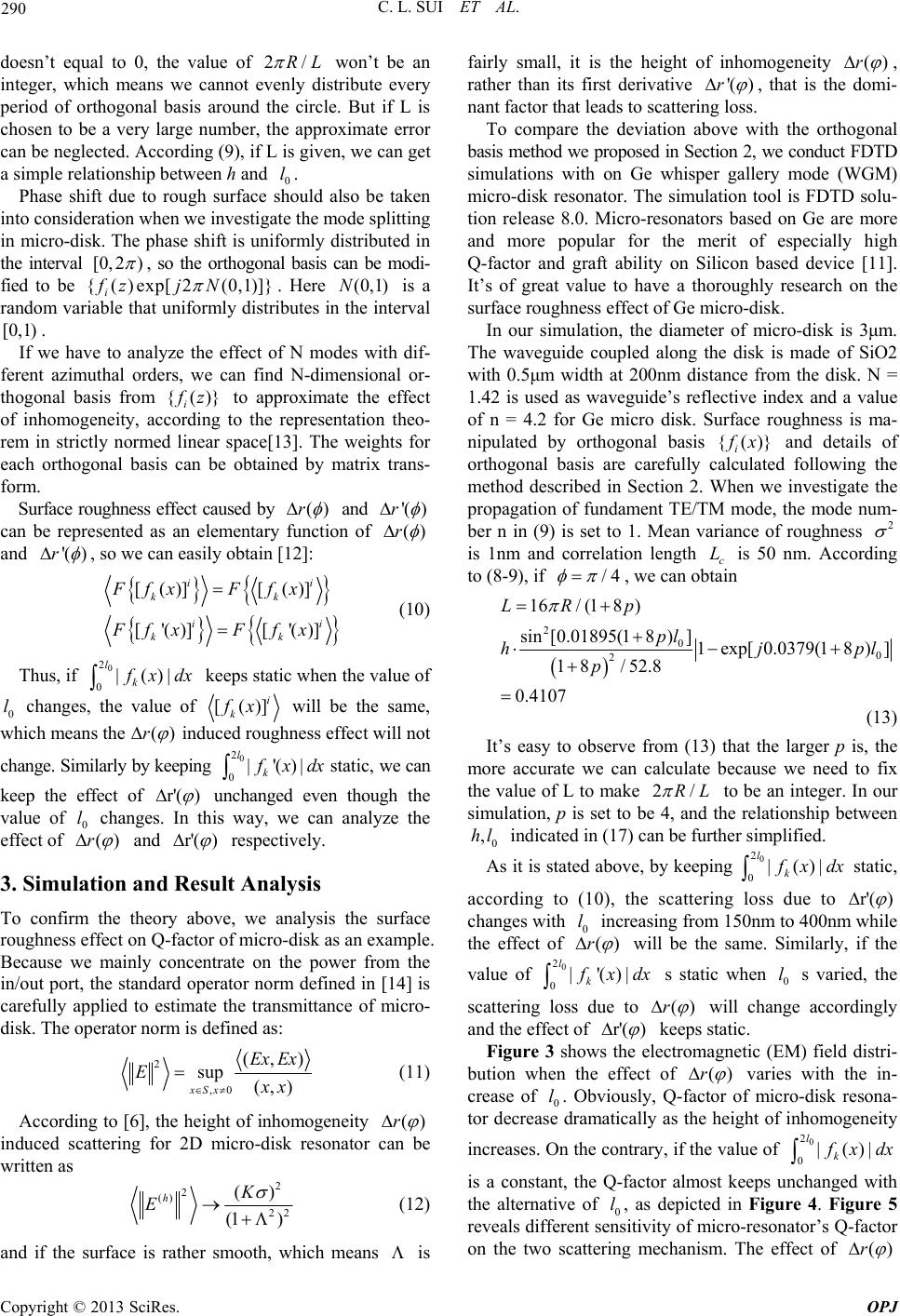
C. L. SUI ET AL.
290
doesn’t equal to 0, the value of 2/RL
won’t be an
integer, which means we cannot evenly distribute every
period of orthogonal basis around the circle. But if L is
chosen to be a very large number, the approximate error
can be neglected. According (9), if L is given, we can get
a simple relationship between h and .
0
Phase shift due to rough surface should also be taken
into consideration when we investigate the mode splitting
in micro-disk. The phase shift is uniformly distributed in
the interval
l
[0,2 )
, so the orthogonal basis can be modi-
fied to be i
{() efz xp[ 2(0,1)j N]}
. Here is a
random variable that uniformly distributes in the interval
.
(0,1)N
[0,1)
If we have to analyze the effect of N modes with dif-
ferent azimuthal orders, we can find N-dimensional or-
thogonal basis from {()}
i
z to approximate the effect
of inhomogeneity, according to the representation theo-
rem in strictly normed linear space[13]. The weights for
each orthogonal basis can be obtained by matrix trans-
form.
Surface roughness effect caused by ()r
and '( )r
can be represented as an elementary function of ()r
and '( )r
, so we can easily obtain [12]:
[()]
['()]
ii
ii
kk
fx
fx
[()]
['()]
kk
Ffx F
FfxF
(10)
Thus, if 0
2
0|()|
l
k
xdx
keeps static when the value of
0
l changes, the value of [()
i
k]
x will be the same,
which means the ()r
nduced roughness effect will not
change. Similarly by keeping 0
2|'()|
l
i
0k
xdx
static, we can
keep the effect of r'()
unchanged even though the
value of 0
l changes. In this way, we can analyze the
effect of ()r
and r'()
respectively.
3. Simulation and Result Analysis
To confirm the theory above, we analysis the surface
roughness effect on Q-factor of micro-disk as an example.
Because we mainly concentrate on the power from the
in/out port, the standard operator norm defined in [14] is
carefully applied to estimate the transmittance of micro-
disk. The operator norm is defined as:
2
,0
(, )
sup (,)
xSx
Ex Ex
Exx
(11)
According to [6], the height of inhomogeneity ()r
induced scattering for 2D micro-disk resonator can be
written as
2
2
()
22
()
(1 )
hK
E
(12)
and if the surface is rather smooth, which means is
fairly small, it is the height of inhomogeneity )(r
,
rather than its first derivative '( )r
, that is the-
nant factor that leads to scattering loss.
To compare the deviation above wit
domi
orthogonal
is 3μm.
h the
ba
-disk
Th
sis method we proposed in Section 2, we conduct FDTD
simulations with on Ge whisper gallery mode (WGM)
micro-disk resonator. The simulation tool is FDTD solu-
tion release 8.0. Micro-resonators based on Ge are more
and more popular for the merit of especially high
Q-factor and graft ability on Silicon based device [11].
It’s of great value to have a thoroughly research on the
surface roughness effect of Ge micro-disk.
In our simulation, the diameter of micro
e waveguide coupled along the disk is made of SiO2
with 0.5μm width at 200nm distance from the disk. N =
1.42 is used as waveguide’s reflective index and a value
of n = 4.2 for Ge micro disk. Surface roughness is ma-
nipulated by orthogonal basis {()}
i
x and details of
orthogonal basis are carefully calculated following the
method described in Section 2. When we investigate the
propagation of fundament TE/TM mode, the mode num-
ber n in (9) is set to 1. Mean variance of roughness 2
is 1nm and correlation length c
L is 50 nm. Accord
to (8-9), if /4
ing
, we can obtain
2
0
2
/ (18
sin [0.01895(18)]0.0379(18)]
18 /52.8
0.4107
R
pl pl
p0
16 )L p
1 exp[hj
(13)
from (1e larger p is
3) that thIt’s easy to observe
m
, the
ore accurate we can calculate because we need to fix
the value of L to make 2/RL
to be an integer. In our
simulation, p is set to be 4, and the relationship between
0
,hl indicated in (17) can be further simplified.
s it is stated above, by keeping 0
2|()|
l
k
A0
xd
x static,
acss due to cording to (10), the scattering r'( )
lo
changes with 0
l increasing from 150nm to 400nm
the effect of ()r while
will be the same. Similarly, if the
value of 0
2|
l
0|'()
k
xdx
s static when 0
l s varied, the
scattering ()r
loss due to
will chan e accordingly g
and the effect of r'( )
kee static.
Figure 3 showlectromagnetic
p
e
s
s the (EM) field distri-
bution when the effect of ()r
varies with the in-
crease of 0
l. Obviously, Q-f micro-disk resona-
tor decreasramatically as the height of inhomogeneity
increases. On the contrary, if the value of 0
2|()|
l
k
actor of
e d
0
xdx
is a constant, the Q-factor almost keeps u nchanged with
the alternative of 0
l, as depicted in Figure 4. Figure 5
reveals different sensitivity of micro-resonator’s Q-factor
on the two scattering mechanism. The effect of ()r
Copyright © 2013 SciRes. OPJ